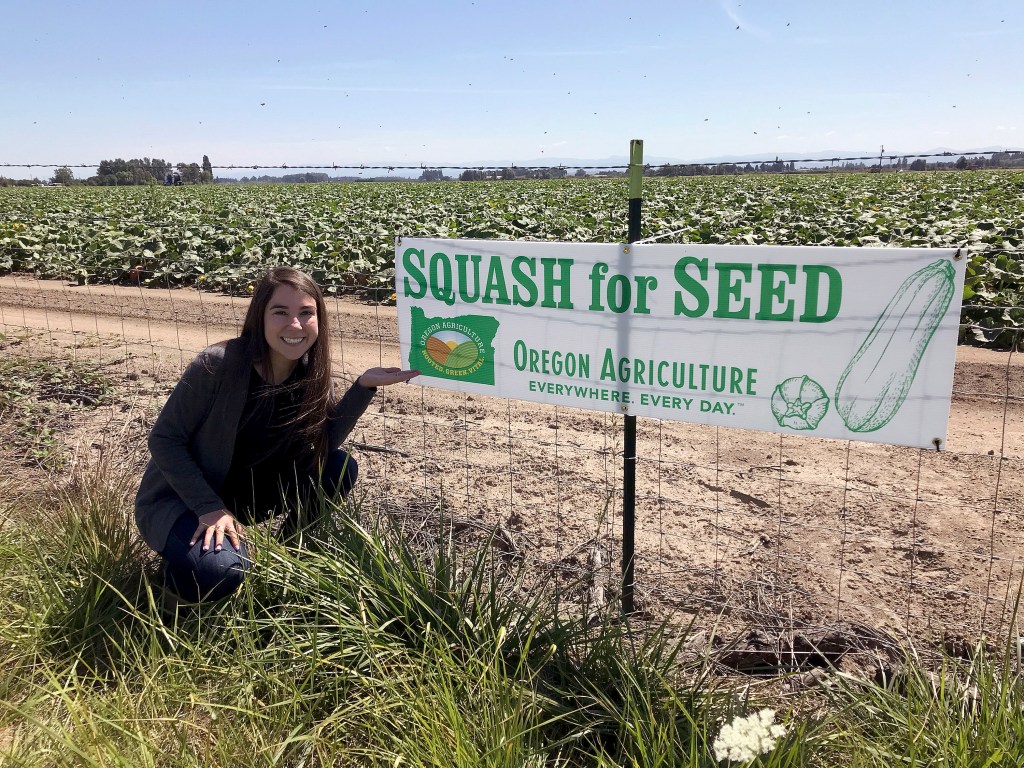It’s a sign: crop identification signs help bridge urban-rural divide
Published 5:00 am Friday, September 27, 2019

- Volunteer Jackie Santa Cruz beside a crop identification sign labeling squash for seed.
Along Oregon roads and highways, crop identification signs help drivers recognize what’s growing and living in fields they pass. Potatoes, hazelnuts, honey bees.
“The signs educate and spark curiosity,” said Allison Cloo, director of membership and programs at Oregon Aglink, the organization that creates the signs. “It’s the idea of the landscape working. Even if it you don’t see people in it, the field is working, growing and making food. It’s doing something important.”
Crop identification signs are labor-intensive and must be monitored over time. But the signs, said Cloo, are worth the effort because they help connect urban and rural people.
Over the past 10 years, Oregon Aglink has sold more than 900 identification signs representing 130 crops and varieties across Oregon.
The sign-making venture started in 1983 in the garage of Pat Coon, Linn-Benton chapter member of Oregon Women for Agriculture (OWA). Volunteers rubbed sticky letters on hand-made signs.
Initially, OWA erected signs at no cost to farmers. As the program evolved and orders poured in, however, OWA recognized the program couldn’t sustain itself. In 1986, OWA handed leadership to Oregon Aglink, then called Agri-Business Council.
Oregon Aglink now charges farmers for signs — $75 for large crop signs and $40 for small variety signs. A crop sign might say, “Wine grapes.” A variety sign might further classify, “Pinot gris.”
OWA still pays for some signs and puts them along highly-trafficked routes. Dona Coon, the founder’s daughter-in-law and committee chair of the crop identification program, said OWA raised $6,000 in donations in 2018 for new signs.
Coon said the program is popular because it unites people.
“The divide between urban and rural people has always been there,” said Coon. “It’s a little more filled with angst right now. These signs help fill that divide. People drive by a field with no idea what it is — meadowfoam for hair and makeup, chicory as a coffee substitute, coriander for cooking. There are so many varieties of wheat alone. If people make the connection in their head and see how it affects their daily lives, how it’s part of the economy, I think it brings people together.”
A lot of behind-the-scenes work goes into each sign, Cloo said.
For each new crop, Oregon Aglink chooses words carefully. For example, “organic” is excluded since the signs should be educational rather than promotional, and hemp signs say the plants contain less than 0.3% THC.
Oregon Aglink works with mechanics to create sturdy signs and a designer to make accurate illustrations. Volunteers put up the signs.
The biggest challenge, Cloo said, is ensuring the signs stay up-to-date when farmers rotate crops.
Despite challenges, Coon said the signs have received a positive response from Oregon communities.
Dennis Glaser, 72, owns about 6,000 acres, primarily of grass seed, south of Albany. His family has been farming since 1895. Glaser has about nine signs on his land.
“Most people are getting so far away from agriculture they have little concept of where their food and fiber come from,” said Glaser. “These signs help with that. I think people often drive the freeway without noticing what’s off to the side. But sometimes people honk their horns just to say hello when they pass the fields. You know they’re looking. They see the signs. And they see you.”

